Shares in the Royal Bank of Scotland (RBS) reportedly went up by 6% yesterday, on news that their losses for the past year – at a mere £3.6 billion compared to the £24.3 billion the previous year - “were better than expected”! This substantial loss, being much “better than expected”, also allowed RBS to pay out some £1.3 billion in bonuses to their employees. Apparently if they did not pay out these vast sums, the talent of these employees, which gave them a loss of £24 billion last year and £3.6 billion this year, might leave for other banks (presumably ones also dependent on government handouts).
Meanwhile the Lloyd’s group reported losses of £6.3 billion for last year, but were apparently very upbeat because they expected a “significant improvement” for 2010.
And the gullible have sent the shares of RBS up by 6%.
It reminds one of the friar who consumed one bottle of scotch per day and landed an appointment at a seminary, where drinking was forbidden. Once the Father Superior became aware of the friar’s drinking habits, he gave him a severe dressing down and told him to stop it.
So the friar cut down his consumption of whiskey to half a bottle per day. This earned him the gratitude and friendship of all at the seminary.
It has been postulated that the dopaminergic neurons in the reward centres of the brain are more active during the expectation of reward than when the reward is obtained. Perhaps this explains why rewards are often disappointing.
But what if the reward far exceeds expectations, as a diminution in loss to a mere £3.6 billion, obviously was.
Would this entail an even more vigorous activity by these dopaminergic neurons?
An interesting brain experiment for neuroeconomics?
Friday, February 26, 2010
Tuesday, February 23, 2010
Economic "experts"
This week "Forum", a BBC World Service Programme, featured a very perspicacious man - Moises Naim - a former Venezuelan Trade and Industry Minister. He summed up very nicely what so many think about economists and their spectacular failure in predicting what they profess to be able to predict. Without actually saying so, he perhaps conveyed very well the deep contempt in which economists are held worldwide and even suggested briefly that they might learn from neurobiological experiments. I doubt that economists would want to listen to him, but for the rest of us he is worth listening to.
Sunday, February 21, 2010
London Underground and the Concept of “Defensible Space”
Over the past few years, London Underground has seen great improvements. And vast sums are being spent on improving it, no doubt in preparation for the Olympics in 2012.
But there has been one very retrograde step – the removal of arm rests between seats on some lines.
Arm rests act not only as arm rests but as aids in defining our territory while we are sitting there. And territoriality is one of the most primitive instincts we have.
Airlines give you better scope to defend your space or be oblivious to it, at a price.
Travellers in steerage have almost no defence and have to fight to define their space on the arm rest, sometimes leading to considerable aggravation.
But for a considerable extra sum, one can travel in business class, where there is far less chance of one’s territory being invaded. Still, the danger exists. I saw two people struggling in business class on a flight from Japan until one of them begged to be seated elsewhere. Unfortunately, the plane was full and he had to endure the misery of having his space invaded for the rest of the long flight.
And for a huge extra sum, one can travel in first class, where the problem does not even arise.
London Underground keep telling us that they are investing vast sums to make our journeys safer, more punctual and pleasanter.
Pleasanter? If they had bothered to read a little about the psychology of territoriality, they may not have abolished those arm rests, which no doubt reduce the amount of angst among passengers as they struggle – instinctively – to defend their space. Their removal makes for a less pleasant journey.
The concept of defensible space is one that all those engaged in such enterprises should look up. Unless, of course, their aim is to make life less pleasant.
But there has been one very retrograde step – the removal of arm rests between seats on some lines.
Arm rests act not only as arm rests but as aids in defining our territory while we are sitting there. And territoriality is one of the most primitive instincts we have.
Airlines give you better scope to defend your space or be oblivious to it, at a price.
Travellers in steerage have almost no defence and have to fight to define their space on the arm rest, sometimes leading to considerable aggravation.
But for a considerable extra sum, one can travel in business class, where there is far less chance of one’s territory being invaded. Still, the danger exists. I saw two people struggling in business class on a flight from Japan until one of them begged to be seated elsewhere. Unfortunately, the plane was full and he had to endure the misery of having his space invaded for the rest of the long flight.
And for a huge extra sum, one can travel in first class, where the problem does not even arise.
London Underground keep telling us that they are investing vast sums to make our journeys safer, more punctual and pleasanter.
Pleasanter? If they had bothered to read a little about the psychology of territoriality, they may not have abolished those arm rests, which no doubt reduce the amount of angst among passengers as they struggle – instinctively – to defend their space. Their removal makes for a less pleasant journey.
The concept of defensible space is one that all those engaged in such enterprises should look up. Unless, of course, their aim is to make life less pleasant.
Le Crazy Horse in Paris
Le Crazy Horse in Paris used to be a great cabaret – I recall many years ago a very aesthetic show in which, through a very clever arrangement of lighting, one only got a glimpse of the girls on parade – from which one was expected, I suppose, to reconstruct the rest (but the brain is able to recognize a form with exposures as brief as 16 milliseconds).
Those days are gone. Le Crazy Horse is now an over-priced cabaret – or rather a cross between a cabaret and a theatre – with a boring show, a faded carbon-copy of its former self.
I last visited it some two years ago, and the only thing I retain is a handout leaflet which said that they had the world’s “most beautiful and most inaccessible women”.
Those who wrote that line are smart – for inaccessibility is the key to the fantasy world recreated there. It is the inaccessibility that creates endless possibilities – in the mind. Once something is totally accessible, it is also rigidly defined, and hence limits the precious role of fantasy.
I suppose that for Dante, too, Beatrice was inaccessible, opening up extraordinary possibilities in his mind. Had she been accessible, he may not have written of her as he did. After all, he has nothing to say about his wife, who must have been totally accessible.
The gulf between the inaccessible girls at Le Crazy Horse and Beatrice is not quite as wide as may seem, although some may be outraged at the suggestion.
But fantasy obviously comes at a price – and viewing those inaccessible girls at Le Crazy Horse is now for those who have cash to spare. What they are paying for is not really a glimpse of the girls at all, but the world of fantasy that that view provides.
And why not?
Those days are gone. Le Crazy Horse is now an over-priced cabaret – or rather a cross between a cabaret and a theatre – with a boring show, a faded carbon-copy of its former self.
I last visited it some two years ago, and the only thing I retain is a handout leaflet which said that they had the world’s “most beautiful and most inaccessible women”.
Those who wrote that line are smart – for inaccessibility is the key to the fantasy world recreated there. It is the inaccessibility that creates endless possibilities – in the mind. Once something is totally accessible, it is also rigidly defined, and hence limits the precious role of fantasy.
I suppose that for Dante, too, Beatrice was inaccessible, opening up extraordinary possibilities in his mind. Had she been accessible, he may not have written of her as he did. After all, he has nothing to say about his wife, who must have been totally accessible.
The gulf between the inaccessible girls at Le Crazy Horse and Beatrice is not quite as wide as may seem, although some may be outraged at the suggestion.
But fantasy obviously comes at a price – and viewing those inaccessible girls at Le Crazy Horse is now for those who have cash to spare. What they are paying for is not really a glimpse of the girls at all, but the world of fantasy that that view provides.
And why not?
Sunday, February 14, 2010
The bite in the apple
I always assumed that the bite in the apple which is the logo of Apple Mac represents eating from the tree of knowledge of good and evil - though I never bothered to enquire.
I was told yesterday by a seemingly well informed person that it is meant to represent a bit of computer history - the bite that Alan Turing, the brilliant English scientist and decoder of Enigma, took from an apple dipped in cyanide. This was his way of commiting suicide after being hounded by the authorities for his homosexuality.
Is this well known?
As an interesting aside, following a recent petition to Downing Street, Gordon Brown, the Prime Minister, apologised on behalf of the British Government for the way in which Turing was treated, which was a decent thing to do.
I was told yesterday by a seemingly well informed person that it is meant to represent a bit of computer history - the bite that Alan Turing, the brilliant English scientist and decoder of Enigma, took from an apple dipped in cyanide. This was his way of commiting suicide after being hounded by the authorities for his homosexuality.
Is this well known?
As an interesting aside, following a recent petition to Downing Street, Gordon Brown, the Prime Minister, apologised on behalf of the British Government for the way in which Turing was treated, which was a decent thing to do.
The specificity of synaesthetic memories
Synaesthesia is a condition in which experience in one modality (for example auditory) triggers an experience in another (for example vision). Commonly a specific note or number generates a specific colour. This naturally argues for a very specific set of connections in the brain – from say a specific part of the auditory cortex to a specific part of the visual brain - in fact to the colour centre (V4). And not only to any part of V4, but the part in which that specific colour is generated and registered. [It is known that there are groupings of cells in V4 that prefer specific colours].
But if my experience is anything to go by, synaesthesia also affects memory in highly specific ways.
I often listen to BBC Radio 4 in the evening, just before the shipping forecast at about 23:45 and the news at midnight. The shipping forecast is preceded by a tune known as sailing by. I cannot be the only one in whom the music conjures up the sea and a boat – that, after all is the title of the tune. But the mental image the music triggers in me – which is always very clear – is also very precise. It is not, as one might imagine, of the rough seas around the British isles, but of a clear, azure blue sea, more like the sea one encounters in the Aegean, around the Greek and Turkish coasts. The boat I see is not any boat but an old fashioned one, of which a perfect example can be seen here. And I am always looking from the boat at the sea.
I have been listening to this tune for years and the mental visual image it creates has never changed. This argues for a highly specific set of connections that link the visual memory system with the immediate auditory input. Experts might have other terms to describe the phenomenon; for all I know it may not even fall under the term synaesthesia. But whatever term one might choose to describe it, the fact remains that it is testament to an astonishing specificity in cortical connections.
But if my experience is anything to go by, synaesthesia also affects memory in highly specific ways.
I often listen to BBC Radio 4 in the evening, just before the shipping forecast at about 23:45 and the news at midnight. The shipping forecast is preceded by a tune known as sailing by. I cannot be the only one in whom the music conjures up the sea and a boat – that, after all is the title of the tune. But the mental image the music triggers in me – which is always very clear – is also very precise. It is not, as one might imagine, of the rough seas around the British isles, but of a clear, azure blue sea, more like the sea one encounters in the Aegean, around the Greek and Turkish coasts. The boat I see is not any boat but an old fashioned one, of which a perfect example can be seen here. And I am always looking from the boat at the sea.
I have been listening to this tune for years and the mental visual image it creates has never changed. This argues for a highly specific set of connections that link the visual memory system with the immediate auditory input. Experts might have other terms to describe the phenomenon; for all I know it may not even fall under the term synaesthesia. But whatever term one might choose to describe it, the fact remains that it is testament to an astonishing specificity in cortical connections.
Subscribe to:
Posts (Atom)

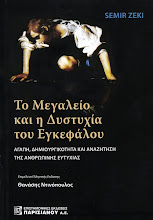
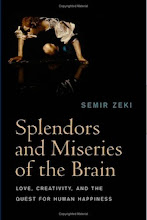
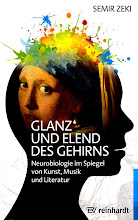
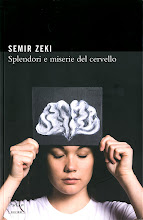



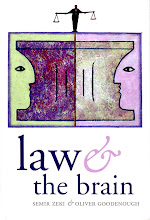
 Contact us
Contact us